The automotive world is continuously evolving, and the compact SUV segment is no exception. Among the latest contenders in this increasingly competitive field are the Fiat 600 and Nissan Juke. Both vehicles cater to urban drivers seeking practicality, style, and innovation. In this article, we’ll compare the technical specifications and distinctive features of these two models to help you decide which one reigns supreme.
Fiat 600 vs Nissan Juke – Which model is better for everyday use?
Compare performance, boot capacity, efficiency and price at a glance.
Find out which car is the better choice for you – Fiat 600 or Nissan Juke?
Price and Variants
Price is often a decisive factor when selecting a new vehicle. The Fiat 600 comes with a range of prices starting from €24,990 to €42,490, depending on the features you opt for. This price tier offers various configurations suited for different preferences and budgets.
On the other hand, the Nissan Juke starts at a slightly lower base price of €24,790, going up to €34,890. The Juke also provides several variants, catering to various driving needs and preferences, including petrol and hybrid options. The entry-level Juke models are priced competitively, making them appealing to a broad audience.
Engine Options and Performance
Under the hood, the Fiat 600 offers a choice of a petrol MHEV engine and a fully electric variant, with power outputs ranging from 100 HP to an impressive 156 HP. The electric range of 409 km is a standout feature, appealing to eco-conscious consumers.
The Nissan Juke, on the other hand, offers a broader range of engines with power ratings from 114 HP to 143 HP. Among its collection, traditional petrol engines and a full hybrid option are available, providing flexibility for those who desire an hybrid driving experience.
Acceleration figures are comparable, with the Fiat 600 achieving 0-100 km/h in as little as 8.5 seconds compared to the Juke’s best time of 10.1 seconds. Both vehicles feature front-wheel-drive systems, which enhance urban maneuverability.
Fuel Efficiency and CO2 Emissions
When it comes to fuel efficiency, the Fiat 600 shines with a consumption rate of just 4.8 L/100 km for its petrol engine variants. The electric version produces zero emissions, earning it a Class A CO2 efficiency rating, which is appealing for environmentally aware buyers.
In contrast, the Nissan Juke's fuel consumption ranges from 4.7 to 6 L/100 km, depending on the engine choice, with CO2 emissions between 107 to 137 g/km. While not as efficient as the Fiat, the Juke still holds its ground in terms of efficiency and cost-effectiveness for hybrid options.
Interior, Comfort, and Technology
Interior dimensions play an essential role in the user experience. The Fiat 600 has a slightly more compact design with a trunk capacity of 385 liters, while the Juke leads in practicality with a more spacious trunk of 422 liters. Both vehicles comfortably seat five, making them suitable for families or groups of friends.
Innovative technology features include the Fiat's advanced infotainment system, which incorporates intuitive smartphone connectivity and modern driver assistance features. Meanwhile, the Nissan Juke is equipped with Nissan's renowned safety and connectivity suite, making it a tech-savvy option.
Dimensions and Design
Dimensionally, the Fiat 600 measures 4178 mm in length, 1779 mm in width, and 1525 mm in height. Conversely, the Juke is slightly longer at 4210 mm and wider at 1800 mm, making it feel more substantial on the road. However, the more compact Fiat may be easier to navigate through tight urban confines.
In terms of aesthetics, both vehicles boast modern designs that reflect their brands' identities. The Fiat 600 has a more traditional yet stylish appearance, while the Juke is celebrated for its bold, sporty stance and unique design cues.
Conclusion: Choosing Between the Fiat 600 and Nissan Juke
The comparison between the Fiat 600 and Nissan Juke ultimately boils down to individual needs and preferences. The Fiat 600 may appeal more to eco-conscious buyers and those seeking the latest technology, while the Juke provides a robust range of engine options, striking style, and practical space for families.
Both models offer distinct advantages, proving that the compact SUV market is alive with choices that cater to diverse driving experiences. As you explore these contenders, consider what fits your lifestyle best, and enjoy the journey towards your new car!
Here’s where it gets real: The technical differences in detail
Costs and Efficiency:
When it comes to price and running costs, the biggest differences usually appear. This is often where you see which car fits your budget better in the long run.
Nissan Juke has a slight advantage in terms of price – it starts at 21400 £, while the Fiat 600 costs 21800 £. That’s a price difference of around 463 £.
Fuel consumption also shows a difference: Nissan Juke manages with 4.70 L and is therefore hardly perceptible more efficient than the Fiat 600 with 4.80 L. The difference is about 0.10 L per 100 km.
Engine and Performance:
Power, torque and acceleration say a lot about how a car feels on the road. This is where you see which model delivers more driving dynamics.
When it comes to engine power, the Fiat 600 has a minimal edge – offering 156 HP compared to 143 HP. That’s roughly 13 HP more horsepower.
In acceleration from 0 to 100 km/h, the Fiat 600 is to a small extent quicker – completing the sprint in 8.50 s, while the Nissan Juke takes 10.10 s. That’s about 1.60 s faster.
In terms of top speed, the Fiat 600 performs hardly perceptible better – reaching 200 km/h, while the Nissan Juke tops out at 180 km/h. The difference is around 20 km/h.
There’s also a difference in torque: Fiat 600 pulls evident stronger with 260 Nm compared to 200 Nm. That’s about 60 Nm difference.
Space and Everyday Use:
Beyond pure performance, interior space and usability matter most in daily life. This is where you see which car is more practical and versatile.
Both vehicles offer seating for 5 people.
In curb weight, Nissan Juke is barely noticeable lighter – 1274 kg compared to 1355 kg. The difference is around 81 kg.
In terms of boot space, the Nissan Juke offers slight more room – 422 L compared to 385 L. That’s a difference of about 37 L.
In maximum load capacity, the Nissan Juke performs slight better – up to 1305 L, which is about 49 L more than the Fiat 600.
When it comes to payload, Fiat 600 minimal takes the win – 430 kg compared to 427 kg. That’s a difference of about 3 kg.
Who wins the race?
The Fiat 600 proves to be leaves the rival little chance and therefore becomes our DriveDuel Champion!
Fiat 600 is the better all-rounder in this comparison.
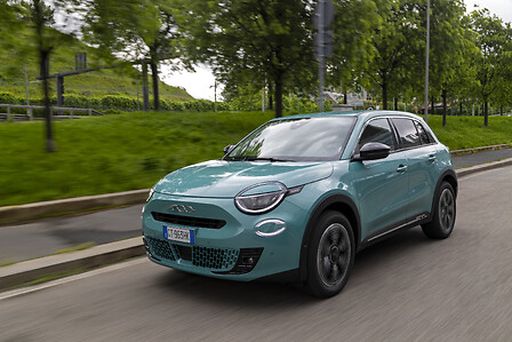 @ Fiat / Stellantis Media
@ Fiat / Stellantis Media
Fiat 600
Fiat 600
The Fiat 600 is small, cheeky and utterly charming, a pocket-sized Italian that packs more personality than its size suggests. Ideal for city buyers who want fuss-free motoring with a playful driving character, it puts smiles ahead of spreadsheets.
details @ Fiat / Stellantis Media
@ Fiat / Stellantis Media
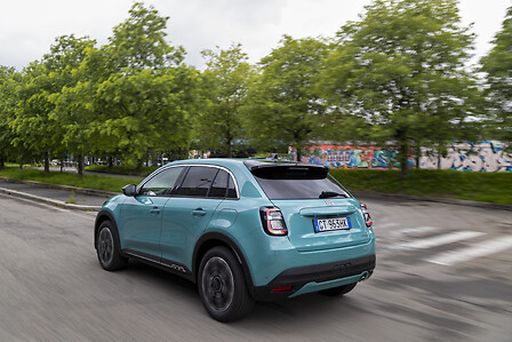 @ Fiat / Stellantis Media
@ Fiat / Stellantis Media
Nissan Juke
The Nissan Juke is a pocket-sized crossover that refuses to blend in, with quirky styling and a cheeky stance that turns heads at every traffic light. It’s ideal for shoppers who value personality and nimble urban driving over maximum practicality, delivering surprising pep and a well-equipped feel for everyday fun.
details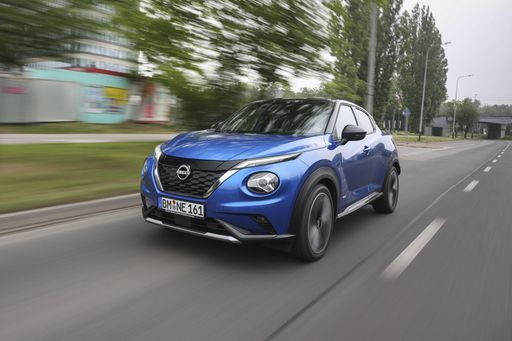 @ Nissan Motor Corporation
@ Nissan Motor Corporation
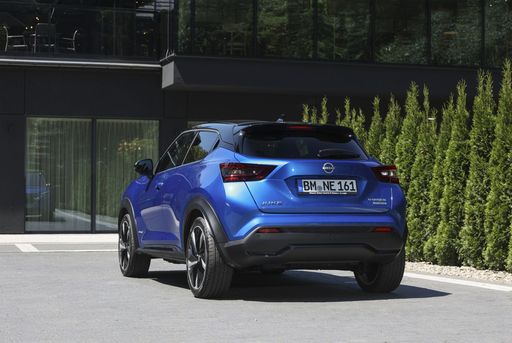 @ Nissan Motor Corporation
@ Nissan Motor Corporation
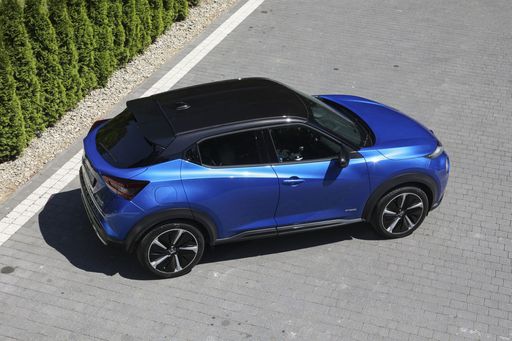 @ Nissan Motor Corporation
@ Nissan Motor Corporation
 @ Nissan Motor Corporation
@ Nissan Motor Corporation
 @ Fiat / Stellantis Media
@ Fiat / Stellantis Media
|
 @ Nissan Motor Corporation
@ Nissan Motor Corporation
|
|
|
|
Costs and Consumption |
|
|---|---|
|
Price
21800 - 31300 £
|
Price
21400 - 30100 £
|
|
Consumption L/100km
4.80 L
|
Consumption L/100km
4.7 - 6 L
|
|
Consumption kWh/100km
15.10 kWh
|
Consumption kWh/100km
-
|
|
Electric Range
409 km
|
Electric Range
-
|
|
Battery Capacity
51 - 52 kWh
|
Battery Capacity
0.60 kWh
|
|
co2
0 - 109 g/km
|
co2
107 - 136 g/km
|
|
Fuel tank capacity
44 L
|
Fuel tank capacity
46 L
|
Dimensions and Body |
|
|---|---|
|
Body Type
SUV
|
Body Type
SUV
|
|
Seats
5
|
Seats
5
|
|
Doors
5
|
Doors
5
|
|
Curb weight
1355 - 1595 kg
|
Curb weight
1274 - 1405 kg
|
|
Trunk capacity
360 - 385 L
|
Trunk capacity
354 - 422 L
|
|
Length
4178 mm
|
Length
4210 mm
|
|
Width
1779 mm
|
Width
1800 mm
|
|
Height
1523 - 1525 mm
|
Height
1593 mm
|
|
Max trunk capacity
1231 - 1256 L
|
Max trunk capacity
1237 - 1305 L
|
|
Payload
427 - 430 kg
|
Payload
405 - 427 kg
|
Engine and Performance |
|
|---|---|
|
Engine Type
Electric, Petrol MHEV
|
Engine Type
Petrol, Full Hybrid
|
|
Transmission
Automatic
|
Transmission
Manuel, Automatic
|
|
Transmission Detail
Reduction Gearbox, Dual-Clutch Automatic
|
Transmission Detail
Manual Gearbox, Dual-Clutch Automatic, Automatic Gearbox
|
|
Drive Type
Front-Wheel Drive
|
Drive Type
Front-Wheel Drive
|
|
Power HP
110 - 156 HP
|
Power HP
114 - 143 HP
|
|
Acceleration 0-100km/h
8.5 - 10.5 s
|
Acceleration 0-100km/h
10.1 - 11.8 s
|
|
Max Speed
150 - 200 km/h
|
Max Speed
166 - 180 km/h
|
|
Torque
205 - 260 Nm
|
Torque
200 Nm
|
|
Number of Cylinders
3
|
Number of Cylinders
3 - 4
|
|
Power kW
81 - 115 kW
|
Power kW
84 - 105 kW
|
|
Engine capacity
1199 cm3
|
Engine capacity
999 - 1598 cm3
|
General |
|
|---|---|
|
Model Year
2023 - 2025
|
Model Year
2024
|
|
CO2 Efficiency Class
A, C
|
CO2 Efficiency Class
D, E, C
|
|
Brand
Fiat
|
Brand
Nissan
|
What drive types are available for the Fiat 600?
The Fiat 600 is available as Front-Wheel Drive.
The prices and data displayed are estimates based on German list prices and may vary by country. This information is not legally binding.
